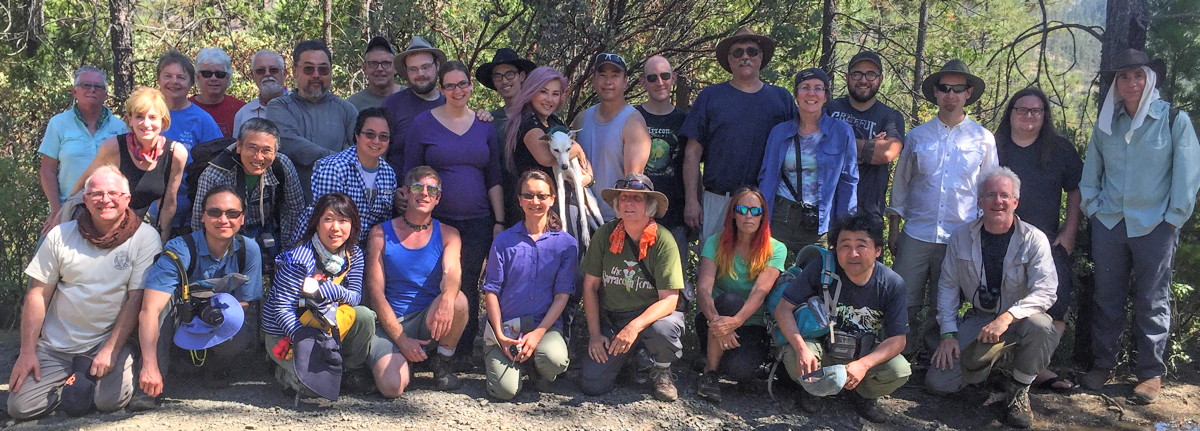
The hardy group of naturalists on the Grand Expedition.
Barry Rice's remembrances of the ICPS 2018 Conference field trip.
Introduction—the group assembles
This year’s ICPS Conference—in California, USA—was conceived, designed, and organized by the Bay Area Carnivorous Plant Society and the staff of California Carnivores, and in particular by Damon Collingsworth. Unfortunately, I was unable to attend the conference, but I was able to help co-lead the field trips. This is a description of a few of the highlights from that portion of the event.
The first day of the trip was 7 August—a Tuesday. The participants piled into two snugly-packed vans and a few passenger cars, and headed from the conference area towards the California-Oregon border. En route, the caravan stopped at Bob Ziemer’s house (the managing editor of Carnivorous Plant Newsletter) to ooh and aah over his extensive collection. Then, they travelled still farther north to Crescent City, for a nice restaurant dinner.
While all this was happening, my wife (Beth Salvia) and I were flying from a Star Trek convention in Las Vegas to Sacramento—stopping at home long enough to repack the car with field trip gear and water the plants—then driving the several hours to Crescent City. We joined the crew around 8 pm, just in time for beers.
Our crew consisted of trip co-leaders Damon Collingsworth and Gina Morimoto, vehicle drivers Luke Basulto and Arthur Yin. Beth and I were largely just there as crowd control. Unfortunately, Daniela Ribbecke—who helped so much in organizing the field trip—was unable to attend. Gasquet local Harry Tryon was also frequently present, and helped provide color and context to what we were seeing. The field trip attendees stayed in a simple but clean motel in the town of Hiouchi, while the co-leaders stayed in the nearby town of Gasquet.
Field Day #1
Wednesday morning we met at a small restaurant in Hiouchi (all restaurants in this remote part of California are small) and overwhelmed the staff with our ravenous breakfast appetites. After a very long time getting everyone fed, we decontaminated our boots with bleach to prevent the spread of Batrachochytrium dendrobatidis (non-native chytrid fungus devastating frog populations world-wide) and Phytophthora lateralis (non-native pathogen killing Port-Orford-cedar, Chamaecyparis lawsoniana). This was the first time I saw how the field trip vans were filled to capacity. Fortunately, most of our travel was short. Most of it.
Our first site was a location known to many as the “covered bridge” site, because of the nearby…covered bridge. Since the site was along a curving mountain road, we co-leaders donned attractive fluorescent green safety vests. Here we all observed water dripping over rocks and scree slope, adorned with many Pinguicula macroceras plants. This site is notable for having “chocolate” plants—that is, Pinguicula with purplish to brown leaves. It was late in the season, but we did manage to find a single plant in flower—our only one for the entire field trip. We also saw our first Darlingtonia—and the first viewing of this plant in the wild for several of the field trip attendees!
After memory cards accumulated many pictures, we repacked the vans with humans and headed to one of my favorite sites—here, the water seeped, trickled, and tumbled down a vertical serpentine wall, to the mountain road below. The Darlingtonia ranged from lightly pigmented to nearly complete red. Strange, snakelike clusters of juvenile pitchers clung to the wet vertical rock face in defiance of physics and probability. Meanwhile, the Pinguicula also thrived, and seedling activity was vigorous. We all photographed madly, interrupted only by group calls of “Car! Car!” by trip leaders whenever curious locals drove past.
After a long time, we drove to a site right on Hwy 199, where the Darlingtonia grew in a moderately dense pine forest. I am quite fond of this site, as it often has wonderfully pigmented plants, including my favorite morph—the red-fanged plants. A few straggly Pinguicula were here too, along with one of our few sightings of Drosera rotundifolia. Unfortunately, far more common were weedy Drosera capensis that were introduced by some fool horticulturist years ago. Orchids were well represented, including past-flowering Cypripedium californicum, Platanthera dilatata var. leucostachys, and Piperia elongata (the latter, in prime flowering shape). Harry and Damon talked to us about Darlingtonia dispersal, and a few pitchers were dissected to look at the midges (Metriocnemus edwardsii) that do much of the digestive work in these pitcher plants.
A few km down the road was our next site—a famous Darlingtonia botanical trail, where we had lunch and walked the ten-minute-trail to look at plants. While the site is superb, I smugly noted that folks were in general not too impressed. As nice as it is, it did not hold a candle to the sites we had visited earlier in the day!
But there was little time to rest! We repacked the vans and drove west, towards the coast, via a winding, winding, winding gravel road that rewarded us a chance to tour Stout Grove and see coast redwoods (Sequoia sempervirens). These enormous, ancient trees are truly awe-inspiring. Visitors walking the trails through these groves always speak in reverential, hushed tones. You feel very much like a visitor in a giant’s home.
After trying (mostly unsuccessfully) to capture the grandeur of the site on our cameras, we headed to Crescent City for a fine seafood-themed restaurant. Friendships were reinforced after a day of exciting field experiences, and shared duress in the packed vans, and many toasts were made. After dinner, Beth and I enjoyed a pitch-black walk among the redwoods, before we all returned to our hotel rooms.
Field Day #2
Our second day, after a very long breakfast (our little restaurant’s staff had not yet adapted to being overwhelmed by the arrival of thirty naturalists), we took a short drive to our first site—a small rocky seepage right in the middle of Gasquet. This sparsely forested site supports Darlingtonia, Pinguicula, and Drosera rotundifolia. It is the best place I know for photographers to try to achieve what we called the trifecta—all three native species in a single photograph. After searching about, we found three such occurrences…hurrah!
I was also happy to see no non-native carnivorous plants there. Many years ago, I visited the site with Peter D’Amato and others, and we found a Sarracenia purpurea hybrid inserted by some horticulturist. I dug it out and unwittingly gave it to Peter—for the rest of that trip, so long ago, every time we reached a new site, Peter playfully tucked the plant in the ground for me to find…again…and again…and again. Peter has a devious sense of humor!
In case people had recovered from the ordeal of the road to Stout Grove the previous day, we squeezed into our vans and ventured onto another narrow dirt road that wound its way through the mountains near Gasquet, and passed several Darlingtonia seepages. Instead of stopping at each, we visited only the best.
The first was a small cataract site, where water tumbled over a vertical rock wall, and amazingly Darlingtonia managed to cling to the slippery sheer surfaces. I was particularly struck by some beautiful Gentiana affinis var. ovata, with blue petals decorated with light green dots. The second site was much larger, and included gentle seepage and large field of Darlingtonia. A third had several small ponds bordered by intensely colored plants, as well as Lilium pardilinum and Rudbeckia californica. Unfortunately, we also observed indications of poaching, where someone had messily spaded out several clumps of plants, and didn’t even bother to try repair the damaged soil structure where they dug the plants. (I spent some time cleaning up after their crime, including trying to reseat some seedling plants they carelessly dug out and left to dry.)
Our time on the road complete, we were all very dry and dusty—in fact some of us took to drawing carnivorous plants in the thick dust coating our vehicles! Indeed, we were so dry that the thought of the nearby Patrick Creek was so overwhelming that we drove there for a rest and a swim. The water was simply perfect—chilly but not overly so, and clear as glass. If you see any photos from the trip showing us swimming and cavorting, that’s the place!
Gina and Damon were keeping us on schedule, but somehow we ended up getting distracted by one unscheduled site where we stopped in a gravel parking area to look at the sheer, exposed mountains above us, where in several places had water seepages. Of course, those places were heavily colonized by Pinguicula, but these could only be observed through our binoculars.
The day drawing to a close, we drove at a mad pace to the ocean to walk on the beach for 11 minutes (that’s what Gina gave us), and then another fine dinner.
Field Day #3
Our last full day in the field had a slightly different flavor. We were to drive northeast, into Oregon, to see Darlingtonia in a different part of its range. However, we had a new hazard—forest fires. In particular, we were heading into areas very near the active Taylor Creek Fire and Klondike Fire, neither of which had been controlled. Because of the extremely hot dry weather we were heading into an area with explosive fire conditions.
While we re-disinfected our boots, Beth and I gave the group a few tips on being fire-wise, since we had—at least in the past—been certified for working on prescribed fires and had experience on fire lines. I had spoken with other naturalists in the area, and they told me the region was open for visitation, but that many fire crews were mobilized in the area. We warned the attendees that, despite our hopes, we might be turned back by fire crew, and even if we reached our destination sites, we had to be ready to evacuate at a moment’s notice.
After a relatively short highway drive, we turned onto successively small roads until we began observing Darlingtonia patches. We stopped at a few along the way, enjoying the spectacularly colored plants that grew in gentle broad seepages. Gentiana setigera and other wildflowers were visible here and there, despite the lateness of the season. This road trip terminated at one of my favorite sites—a very large, nearly flat site filled with Darlingtonia, including many red-keeled plants and red-fanged plants. As on other trips, I marveled that no Utricularia occurred at the site, despite the fact that the slow, wet seepage seemed absolutely ideal for Utricularia minor.
I could tell, by the way that some of our trip participants were clumsily stumbling about, that some folks were getting dehydrated in the heat, so our long lunch by a cool stream provided an excellent rest. It also gave us time to appreciate and enjoy the company given by a rare foothills yellow-legged frog (Rana boylii) in the stream, a frog that was inexplicably given the name Carl.
Back in our vehicles, we headed towards our final site for the day—a location near Eight Dollar Mountain, Oregon. This is a favorite site for many, but we were not sure we would be able to make it—the problem, of course, were the fires.
Driving towards the site, we encountered an incident control station (a checkpoint for fire crew). Discussing the situation with them we concluded we were in a safe situation—although we were to remain vigilant. We drove the dusty road higher into the mountains—passing a few small Darlingtonia patches, until we reached our destination.
I was one of the first to step out of our air-conditioned vehicles, and the heat hit me in the face like a punch. I have never experienced such dry, hot conditions at a carnivorous plant site before. We were at the base of a huge, grassy hill, with a broad ribbon of Darlingtonia that snaked up the slope, to nearly out of sight. It is indeed a spectacular view. And as an added gift, Pinguicula could be found here and there on the steep slope—not in huge numbers, but just a little extra seasoning.
After a quick reminder to all the field trip attendees that they had to return to the car immediately if they heard us honking our horns, the excited naturalists streamed up the slope like children in a candy store. It was a gratifying vision for us trip leaders—I had been hoping that folks would not be tired of Darlingtonia by now, and I was reassured by the occasional whoops of excitement that I heard.
I stayed at the hill’s base, helping the drivers turn the vehicles around on the very narrow road, and generally fretted as I watched the nearby fire smoke plume gradually enlarge. Heat stroke was also a concern in these extreme conditions, and I didn’t like the fact that few folks seemed interested in seeking a bathroom. However, my concerns were—it turned out—unfounded as no one seemed much worse after the hour or two we spent there.
In time, we concluded it was time to leave, so we took a group photo of all the trip participants, piled AGAIN into our vans, and hustled out of the fire area. When we reached a nearby town for dinner, many of us were shocked to look back in the direction of the Darlingtonia site—what was previously a simple smoke plume had exploded into a giant pyrocumulus cloud of enormous dimensions. As I write this, reports indicate that the fire did sweep over the region, and I intend to return in a few weeks to survey the impact.
Last day
The last morning—a Saturday—found us all back at our usual Hiouchi diner for one last big breakfast together. Folks furiously exchanged contact information on social media platforms, and took photo after photo—this time of each other, instead of plants. Thanks were given to all who designed and executed this perfect field trip. Then sadly—oh so forlornly—we bade each other farewell.
One little secret, though… As Beth and I drove away, we couldn’t resist the temptation of….just…one…more…site! So we parked our car, hiked for a bit, until we reached my favorite Pinguicula site of all. (It involves technical bouldering to reach, so it was an inappropriate destination for the field trip group.) It is right along a river, where Pinguicula grow on sheer rock faces at the water’s edge. Not only do the rock walls provide habitat, they also assure complete privacy on the river, so the swimming (uh, clothing optional swimming) is secluded, isolated, and refreshing.
-- Barry Rice
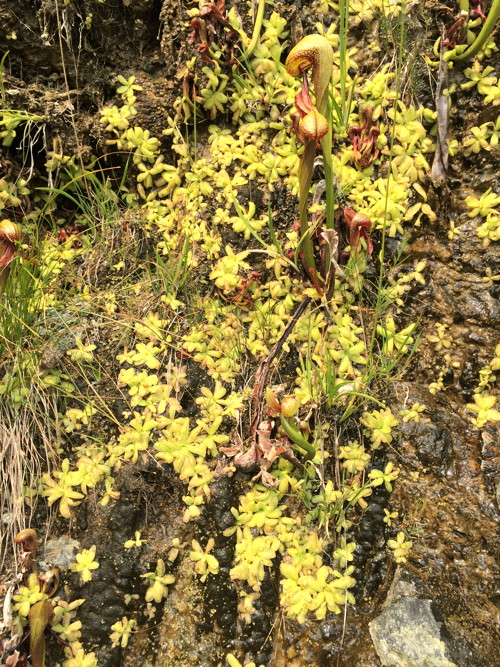
Darlingtonia californica and Pinguicula macroceras on a sheer rock wall.
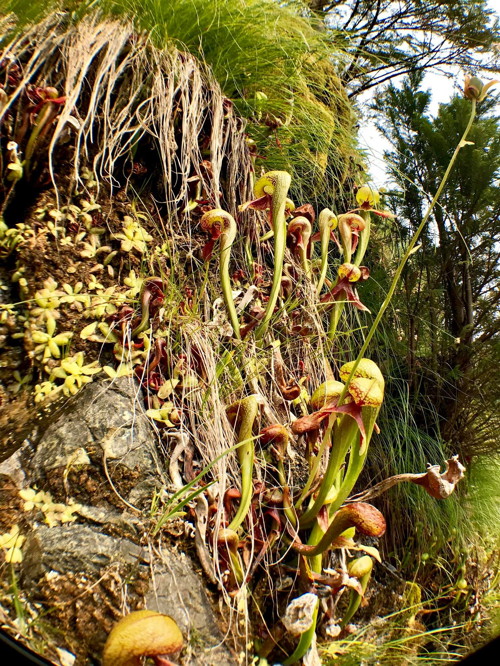
Another view of Darlingtonia californica and Pinguicula macroceras on a sheer rock wall. Photo by Maggie Chen.
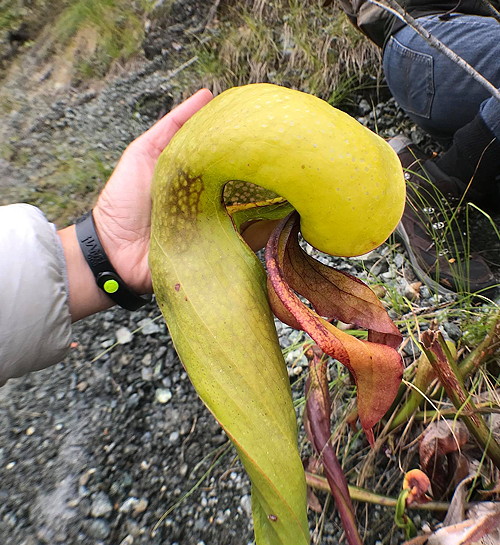
Rather large Darlingtonia californica pitcher. Photo by Maggie Chen.
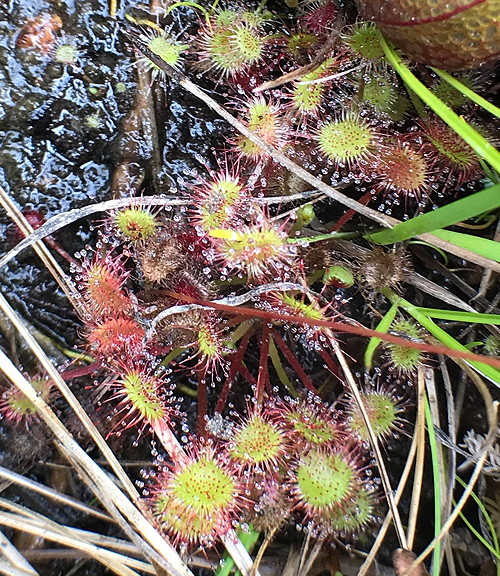
Drosera rotundifolia. Photo by Maggie Chen.
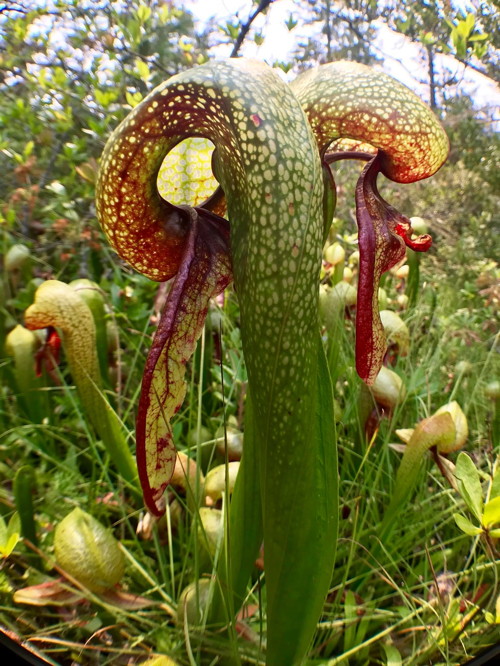
Darlingtonia californica pitchers. Photo by Maggie Chen.
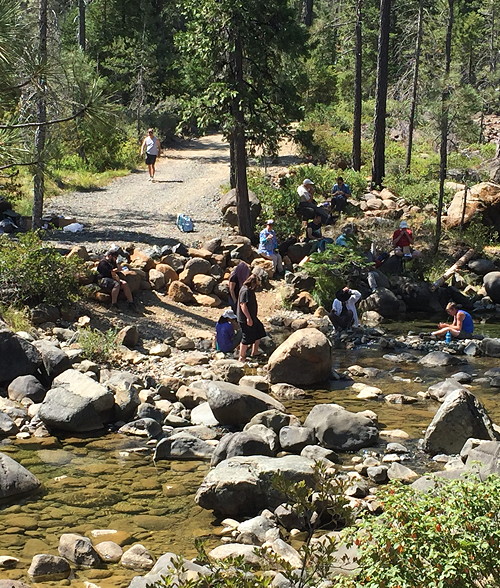
Long lunch by a cool stream. Photo by Beth Salvia.
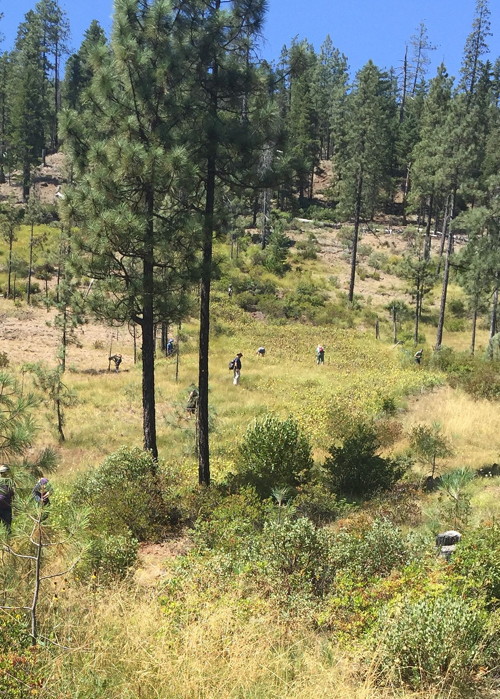
A Darlingtonia site near Selma, Oregon.
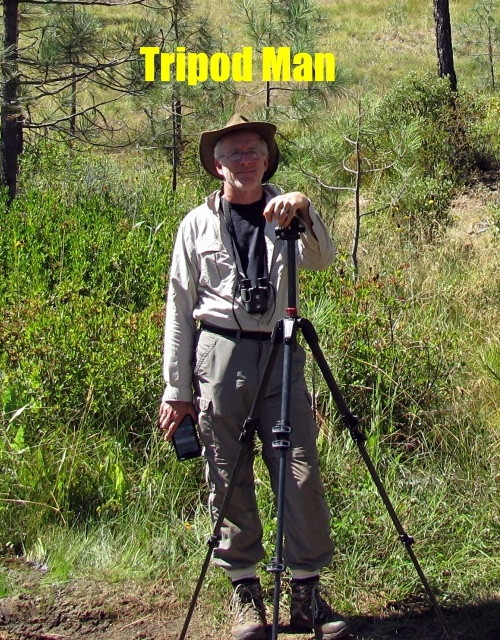
Barry Rice. Photo by Djoni Crawford.
